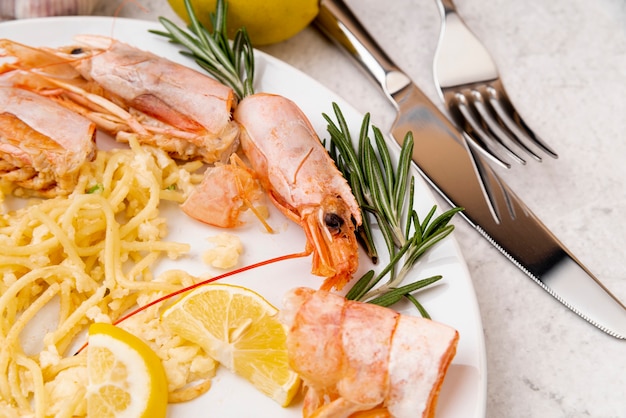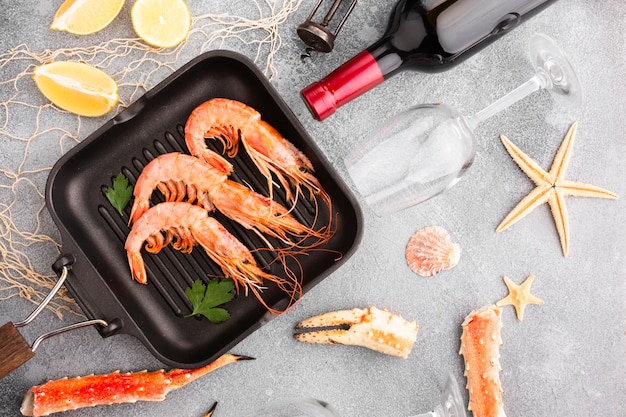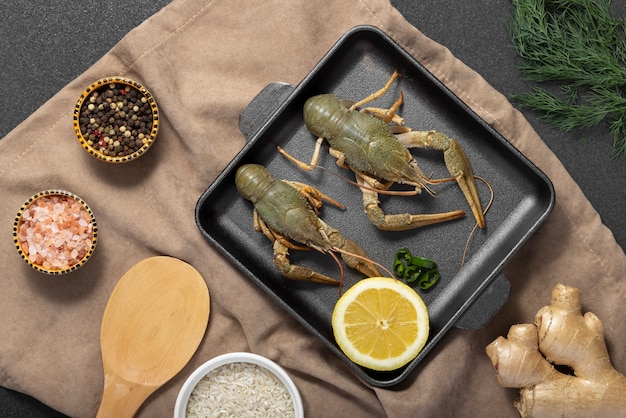There’s nothing quite like the satisfying crack of a crab leg and the taste of sweet, succulent meat. It's a real treat, and even better when you've cooked those crab legs yourself. But sometimes, you just don't have time to head to the fishmonger and find fresh ones. That’s where frozen crab legs come in. They're a great way to enjoy a delicious seafood meal without the hassle. But cooking frozen crab legs can seem intimidating, especially if you've never done it before. Fear not! I'm here to guide you through the process, from defrosting to serving, so you can create a fabulous crab leg feast that'll leave everyone wanting more.
Part 1: The Crucial Prep Work

You can't just throw a bag of frozen crab legs into a pot and expect a gourmet meal. It’s all about getting the prep work right. Think of it like this: You wouldn't bake a cake without preheating the oven, would you? So, let's make sure we're starting this crab leg adventure on the right foot.
1. Defrosting: Gentle Thawing for the Best Results
The key to defrosting frozen crab legs is patience and a gentle touch. You want to avoid letting them thaw at room temperature – that's a recipe for bacterial growth and a less-than-delicious meal. My go-to method is the fridge. It's the most reliable way to ensure your crab legs thaw evenly and safely. Here's how I do it:
- Place in a bowl: Find a bowl big enough to hold the crab legs.
- Cover with cling film: Wrap the crab legs tightly with cling film to prevent them from drying out.
- Refrigerate for 24 hours: Leave them in the fridge for 24 hours to defrost completely.
Of course, sometimes, you need your crab leg fix sooner! If you’re in a rush, you can defrost them in a sink under cold, running water. Just make sure the crab legs are completely submerged in the water. This should take about 30-45 minutes. But remember, the fridge method is always the gentlest and safest way to defrost.
2. A Thorough Wash: Removing the Grit
Once your crab legs are thawed, it's time for a quick rinse under cold water. This washes away any excess salt or grit that might be clinging to the shells. Don't worry, it won't wash away the delicious flavour!
Part 2: Boiling Bliss: The Classic Cooking Method

Boiling is the classic way to cook crab legs. It's a tried-and-true method that consistently delivers tender, flavorful crab meat. I find it's the easiest and most reliable way to cook them.
1. Choosing the Right Pot: A Spacious Container
You'll need a large pot or stockpot, big enough to hold your crab legs without overcrowding. You want plenty of room for the water to circulate and cook the crab legs evenly. Imagine a spacious swimming pool for your crab legs - that's the kind of environment we're aiming for!
2. Flavor Infusion: Seasoning the Water
This is where things get fun! It's time to create a delicious broth that will infuse your crab legs with flavor. Here's my tried-and-true recipe for a flavorful broth:
- Water: Fill the pot with enough water to cover the crab legs by about 2-3 inches. You want to make sure the water is deep enough to completely submerge the crab legs.
- Salt: A generous pinch of salt is essential. Salt helps to season the crab meat and adds a touch of depth to the broth.
- Lemon: The zest and juice of a lemon add a bright, citrusy flavor that complements the sweetness of the crab meat. Don't be shy, add a whole lemon.
- Black Peppercorns: A handful of black peppercorns adds a touch of spice and complexity to the broth.
- Bay Leaf: A bay leaf adds a warm, slightly earthy aroma. You can never go wrong with a bay leaf!
Bring the water to a rolling boil before adding the crab legs. We want a vigorous boil to ensure even cooking.
3. Boiling Time: The Perfect Cook
The cooking time for crab legs depends on their size. This is a bit of a science, so it’s worth getting it right! Here’s a general guideline:
| Size | Cooking Time |
|---|---|
| Small (6-8 inches) | 8-10 minutes |
| Medium (10-12 inches) | 10-12 minutes |
| Large (14-16 inches) | 12-15 minutes |
Remember, you want the crab meat to be cooked through but not overcooked. Overcooked crab meat can become tough and dry. Use tongs or a slotted spoon to carefully remove the crab legs from the boiling water once the cooking time is up. Don’t leave them in the hot water for too long, or they will continue to cook and become dry.
Part 3: Steaming Delights: A Gentle Approach to Cooking

If you prefer a more delicate flavor, steaming is a wonderful alternative to boiling. It's a gentler cooking method that helps to preserve the natural sweetness of the crab meat. Think of it as a spa treatment for your crab legs,
1. Setting the Stage: Your Steaming Equipment
You'll need a steamer basket and a pot with a lid. Fill the pot with about an inch of water and bring it to a boil. Place the steamer basket over the boiling water, making sure it doesn't touch the water. You want the crab legs to steam, not boil.
2. Flavorful Steam: Infusing the Broth
To add flavor to the steam, you can use some of the same ingredients we used for boiling. A few lemon slices, black peppercorns, and a bay leaf will infuse the steam with a delightful aroma. Let the steam infuse with these flavors for a few minutes before adding the crab legs.
3. Steaming Time: Finding the Perfect Balance
The steaming time is similar to boiling. You want to steam the crab legs for 8-15 minutes, depending on their size. Smaller crab legs will require less time, while larger ones need a bit longer. But keep an eye on them, as steaming can happen quickly.
Once the steaming time is up, carefully lift the steamer basket out of the pot and serve the crab legs immediately. They’re ready to be enjoyed!
Part 4: The Cooling Down Period: Essential for Flavor and Safety
You've just cooked your crab legs to perfection, but before you dive in, there's one more crucial step: cooling. You might be thinking, "Why cool them down? I want to eat them hot!" But trust me on this one! There are a couple of good reasons for letting your crab legs cool down a bit.
1. Safety First: Preventing Burns
Hot crab legs are delicious, but they can also be a bit dangerous. Hot, steaming crab legs are a recipe for burned fingers! Allowing them to cool slightly will make them much easier to handle and prevent any accidental burns. It's always better to be safe than sorry, right?
2. Flavor Enhancement: A Taste Revelation
As the crab legs cool, the flavors have a chance to develop and meld together. This is where the real magic happens! You'll notice a richer, more complex flavor profile as the flavors settle and deepen. You'll be amazed at the difference just a little bit of cooling can make.
So, let your crab legs cool for 10-15 minutes before cracking into them. You'll thank me later!
Part 5: Cracking the Code: Unlocking the Deliciousness
Now comes the fun part - cracking open those delicious crab legs! This is where a little bit of skill (and maybe a few tools) come in handy.
1. The Classic Crack: A Hands-On Approach
For the old-school approach, you can simply use your hands. Start by holding the crab leg near the joint, where the leg bends. Then, with a firm grip, bend the leg back and forth until it cracks. Be careful not to squeeze too hard, or you might crush the delicate meat inside. It’s a bit like a gentle wrestling match with the crab leg.
2. Cracking Tools: A Helping Hand
If you're struggling to crack the crab legs with your bare hands, don't worry, there are some helpful tools that can make life easier. A crab cracker is a great option. It's a sturdy tool that helps you apply even pressure to the crab leg, making it easier to crack without crushing the meat. A nutcracker can also be used in a pinch, although it might not be as effective as a dedicated crab cracker.
If you're feeling extra fancy, you can use a pair of kitchen shears to cut through the shell. This method is quick and efficient, but it can be a bit messy.
Part 6: Extracting the Meat: The Art of the Treasure Hunt
You've cracked your crab legs, now it's time to extract that delicious crab meat. It’s a little bit like treasure hunting, and it’s definitely worth the effort.
1. Removing the Shell: A Gentle Touch
Once the crab leg is cracked, use a fork or a pair of tweezers to carefully remove the shell. Be gentle, as the meat can be delicate. Work your way around the shell, slowly peeling it away. You'll be left with a juicy, flavorful piece of crab meat, ready to be savored.
2. Extracting the Meat: The Final Step
Now comes the tricky part. The crab meat is usually tucked into the narrow, leg-shaped portion of the shell. It’s quite delicate, so you’ll need to be gentle. Use a fork or a small spoon to carefully extract the meat from the shell. It takes a bit of patience and a steady hand, but the reward is well worth it!
Part 7: Serving Up a Feast: Beyond the Basics
You've got your perfectly cooked crab legs, now it's time to think about how you're going to serve them. There are so many delicious ways to enjoy this seafood delicacy.
1. The Classic Dip: Melting Butter
Let's be honest, there's no better way to enjoy crab legs than with a generous dollop of melted butter. It's a classic combination for a reason. Simply melt some butter in a small saucepan or a ramekin, and serve it alongside your crab legs. Dip and enjoy! You can also add a squeeze of lemon juice and some chopped fresh herbs to the melted butter for an extra burst of flavor.
2. Beyond Butter: Other Dip Options
If you're looking for something a little different, there are plenty of other dip options to try. Some of my favorites include:
- Cocktail Sauce: A tangy and spicy dip made with ketchup, horseradish, and lemon juice. It's perfect for adding a kick to your crab legs.
- Mignonette: A simple and elegant dip made with red wine vinegar, shallots, and black pepper. It's a refreshing and sophisticated option that complements the sweetness of the crab meat.
- Garlic Butter: A flavorful twist on melted butter, with the added richness of roasted garlic. It's a simple but delicious way to add a touch of garlic flavor to your crab legs.
- Lemon-Dill Sauce: A bright and refreshing sauce made with lemon juice, dill, and mayonnaise. It's a perfect combination for a summery crab leg feast.
Experiment and find your favorite dip – you can’t go wrong!
3. Sides for a Feast: Complementary Flavors
Crab legs are fantastic on their own, but they also pair well with a variety of side dishes. Here are a few ideas to get your creative juices flowing:
- grilled corn on the Cob: A sweet and smoky side that complements the savory flavor of crab legs.
- potato salad: A creamy and classic side that’s always a crowd-pleaser.
- Green Salad: A refreshing and light side that balances the richness of crab legs.
- Roasted Vegetables: A colorful and flavorful side that adds variety to your meal. Try roasting broccoli, asparagus, or Brussels sprouts.
Choose sides that you enjoy and that complement the flavors of your crab legs. Go wild!
Part 8: Leftover Love: Making the Most of the Meat
Let's face it, sometimes you cook a bit too much – or maybe you just want to savor the deliciousness of those crab legs a little longer. Either way, leftovers are a welcome sight!
1. Storage: Keeping the Freshness
The best way to store leftover crab legs is in the refrigerator. Place them in an airtight container and refrigerate for up to 3-4 days. I find it’s best to store the crab meat separately from the shells. This helps to prevent the meat from becoming dry and tough.
2. Leftover Delights: Delicious Second Meals
Don’t think you’re limited to just eating those leftover crab legs cold! Here are a few ideas for putting those tasty morsels to good use:
- Crab Salad: A classic and easy way to use leftover crab meat. Simply combine the crab meat with mayonnaise, celery, onion, and seasonings of your choice. Serve on crackers, toast, or lettuce leaves.
- Crab Cakes: A more substantial way to use leftover crab meat. Combine the crab meat with breadcrumbs, egg, and seasonings, then form into patties and pan-fry or bake until golden brown and cooked through.
- Crab Dip: A delicious appetizer or snack. Combine the crab meat with cream cheese, sour cream, and seasonings of your choice. Serve with crackers, vegetables, or chips.
- Pasta with Crab Meat: A quick and easy pasta dish. Add the crab meat to a simple pasta sauce with garlic, olive oil, and white wine. Toss with your favorite pasta and serve.
Let your imagination run wild! You’ll be amazed at how versatile leftover crab meat can be.
FAQs: Your Crab Leg Queries Answered
I've been there – faced with a bag of frozen crab legs, you're bound to have questions! Here are some of the most common queries I've encountered:
1. Can I Freeze Cooked Crab Legs?
I wouldn't recommend it. Cooked crab legs are best enjoyed fresh. If you must freeze them, I suggest freezing them uncooked. However, the quality of the meat might be compromised after freezing.
2. How Do I Tell if My Crab Legs are Cooked?
There are a few ways to tell if your crab legs are cooked through. The shell should turn a bright red color, indicating that it's cooked. The meat should be opaque and white, not translucent and pink. The flesh should be firm to the touch. If you're still unsure, you can always cut into a leg to check the meat.
3. Can I Eat the Shell?
You can, but it's not really necessary. The shell is mostly made of chitin, which is a type of fiber that our bodies can't digest. It's perfectly safe to eat, but it's not particularly flavorful. Most people prefer to just eat the meat. But if you're feeling adventurous, go for it!
4. What if I Overcook the Crab Legs?
Overcooked crab legs can be tough and dry. If you find that your crab legs are a bit too cooked, there's not much you can do to remedy the situation. But don't worry! You can still enjoy them. Try adding a little more melted butter or a flavorful dip to help compensate for the dryness.
5. Where Can I Buy fresh crab legs?
The best place to buy fresh crab legs is at a seafood market or a grocery store with a good seafood section. Look for crab legs that are firm to the touch, have a fresh smell, and are not discolored. You're going to be eating it, so you want it to be fresh and tasty!
So there you have it – my complete guide to cooking frozen crab legs. I hope this helps you create a delicious and memorable seafood feast. Enjoy!
Everyone is watching

How to Cook Frozen Lobster Tails Perfectly: A Step-by-Step Guide
RecipesLobster. Just the word conjures up images of lavish meals, special occasions, and a taste of luxury. But let's...

Pigs in a Blanket Cooking Time: How Long to Bake for Perfect Results
RecipesAh, pigs in a blanket. Just the name conjures up images of those delightful little parcels of crispy pastry en...

Pork Fillet Cooking Time: How Long to Cook It Perfectly
RecipesPork fillet, or tenderloin as it's sometimes called, is a real favourite in our house. It's so versatile, and...

The Ultimate Guide to Cooking Delicious Frankfurters
RecipesLet's face it, we all love a good frankfurter. It's a classic, simple, and always satisfying. But let's be rea...

Wolf Meat Recipes: A Guide to Cooking Wild Game
RecipesLet's be honest, you don't see wolf meat at your local butcher shop every day. It's a bit of a wild card, but ...
